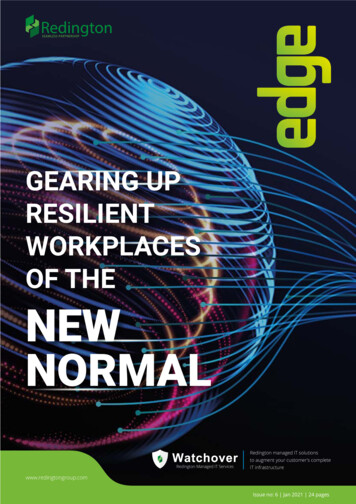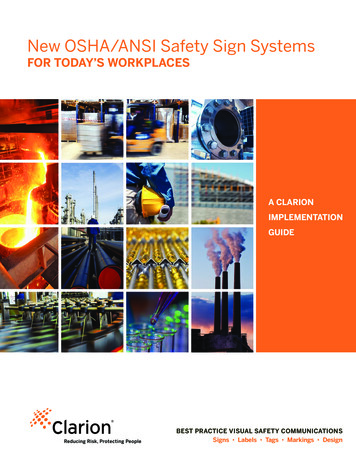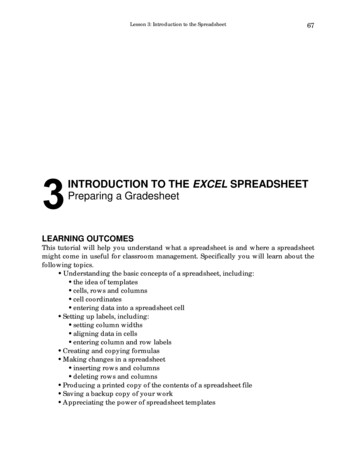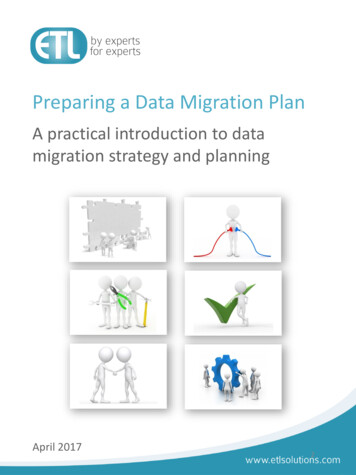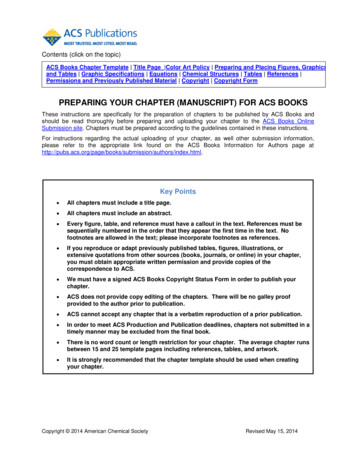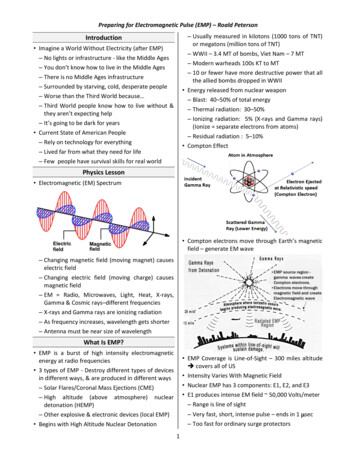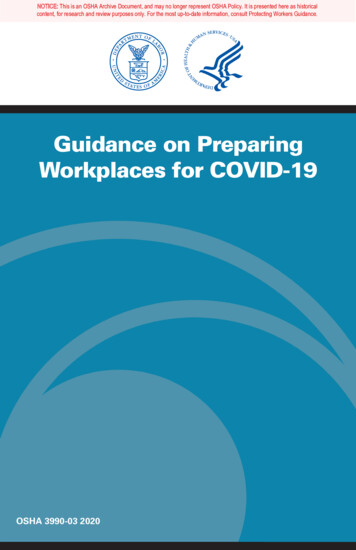
Transcription
NOTICE: This is an OSHA Archive Document, and may no longer represent OSHA Policy. It is presented here as historicalcontent, for research and review purposes only. For the most up-to-date information, consult Protecting Workers Guidance.Guidance on PreparingWorkplaces for COVID-19OSHA 3990-03 2020
Occupational Safety and Health Act of 1970“To assure safe and healthful working conditions forworking men and women; by authorizing enforcementof the standards developed under the Act; by assistingand encouraging the States in their efforts to assuresafe and healthful working conditions; by providingfor research, information, education, and training inthe field of occupational safety and health.”This guidance is not a standard or regulation, andit creates no new legal obligations. It containsrecommendations as well as descriptions ofmandatory safety and health standards. Therecommendations are advisory in nature,informational in content, and are intended to assistemployers in providing a safe and healthful workplace.The Occupational Safety and Health Act requiresemployers to comply with safety and health standardsand regulations promulgated by OSHA or by a statewith an OSHA-approved state plan. In addition, theAct’s General Duty Clause, Section 5(a) (1), requiresemployers to provide their employees with aworkplace free from recognized hazards likely to causedeath or serious physical harm.Material contained in this publication is in the publicdomain and may be reproduced, fully or partially, withoutpermission. Source credit is requested but not required.This information will be made available to sensoryimpaired individuals upon request. Voice phone: (202)693-1999; teletypewriter (TTY) number: 1-877-889-5627.
Guidance on PreparingWorkplaces for COVID-19U.S. Department of LaborOccupational Safety and Health AdministrationOSHA 3990-03 2020
ContentsIntroduction . . . . . . . . . . . . . . . . . . . . . . . . . . . . . . . . . . . . . . . . . . . 3About COVID-19 . . . . . . . . . . . . . . . . . . . . . . . . . . . . . . . . . . . . . . . . 4How a COVID-19 Outbreak Could Affect Workplaces . . . . . . . . . 6Steps All Employers Can Take to ReduceWorkers’ Risk of Exposure to SARS-CoV-2. . . . . . . . . . . . . . . . . . 7Classifying Worker Exposure to SARS‑CoV-2. . . . . . . . . . . . . . . 18Jobs Classified at Lower Exposure Risk (Caution):What to Do to Protect Workers. . . . . . . . . . . . . . . . . . . . . . . . . . 20Jobs Classified at Medium Exposure Risk:What to Do to Protect Workers. . . . . . . . . . . . . . . . . . . . . . . . . . . 21Jobs Classified at High or Very High Exposure Risk:What to Do to Protect Workers. . . . . . . . . . . . . . . . . . . . . . . . . . 23Workers Living Abroad or Travelling Internationally. . . . . . . . . 25For More Information. . . . . . . . . . . . . . . . . . . . . . . . . . . . . . . . . . 26OSHA Assistance, Services, and Programs . . . . . . . . . . . . . . . 27OSHA Regional Offices . . . . . . . . . . . . . . . . . . . . . . . . . . . . . . . . 29How to Contact OSHA. . . . . . . . . . . . . . . . . . . . . . . . . . . . . . . . . 32
IntroductionCoronavirus Disease 2019 (COVID-19) is a respiratory diseasecaused by the SARS-CoV-2 virus. It has spread from China tomany other countries around the world, including the UnitedStates. Depending on the severity of COVID-19’s internationalimpacts, outbreak conditions—including those rising to the levelof a pandemic—can affect all aspects of daily life, includingtravel, trade, tourism, food supplies, and financial markets.To reduce the impact of COVID-19 outbreak conditions onbusinesses, workers, customers, and the public, it is importantfor all employers to plan now for COVID-19. For employers whohave already planned for influenza pandemics, planning forCOVID-19 may involve updating plans to address the specificexposure risks, sources of exposure, routes of transmission,and other unique characteristics of SARS-CoV-2 (i.e., comparedto pandemic influenza viruses). Employers who have notprepared for pandemic events should prepare themselvesand their workers as far in advance as possible of potentiallyworsening outbreak conditions. Lack of continuity planning canresult in a cascade of failures as employers attempt to addresschallenges of COVID-19 with insufficient resources and workerswho might not be adequately trained for jobs they may have toperform under pandemic conditions.The Occupational Safety and Health Administration (OSHA)developed this COVID-19 planning guidance based on traditionalinfection prevention and industrial hygiene practices. It focuses onthe need for employers to implement engineering, administrative,and work practice controls and personal protective equipment(PPE), as well as considerations for doing so.This guidance is intended for planning purposes. Employersand workers should use this planning guidance to helpidentify risk levels in workplace settings and to determineany appropriate control measures to implement. Additionalguidance may be needed as COVID-19 outbreak conditionschange, including as new information about the virus, itstransmission, and impacts, becomes available.GUIDANCE ON PREPARING WORKPLACES FOR COVID-193
The U.S. Department of Health and Human Services’ Centersfor Disease Control and Prevention (CDC) provides thelatest information about COVID-19 and the global outbreak:www. cdc.gov/coronavirus/2019-ncov.The OSHA COVID-19 webpage offers information specificallyfor workers and employers: www.osha.gov/covid-19.This guidance is advisory in nature and informational incontent. It is not a standard or a regulation, and it neithercreates new legal obligations nor alters existing obligationscreated by OSHA standards or the Occupational Safety andHealth Act (OSH Act). Pursuant to the OSH Act, employersmust comply with safety and health standards and regulationsissued and enforced either by OSHA or by an OSHA-approvedState Plan. In addition, the OSH Act’s General Duty Clause,Section 5(a)(1), requires employers to provide their employeeswith a workplace free from recognized hazards likely to causedeath or serious physical harm. OSHA-approved State Plansmay have standards, regulations and enforcement policies thatare different from, but at least as effective as, OSHA’s. Checkwith your State Plan, as applicable, for more information.About COVID-19Symptoms of COVID-19Infection with SARS-CoV-2, the virus that causes COVID-19, cancause illness ranging from mild to severe and, in some cases,can be fatal. Symptoms typically include fever, cough, andshortness of breath. Some people infected with the virus havereported experiencing other non-respiratory symptoms. Otherpeople, referred to as asymptomatic cases, have experiencedno symptoms at all.According to the CDC, symptoms of COVID-19 may appear inas few as 2 days or as long as 14 days after exposure.OCCUPATIONAL SAFETY AND HEALTH ADMINISTRATION4
How COVID-19 SpreadsAlthough the first human cases of COVID-19 likely resultedfrom exposure to infected animals, infected people can spreadSARS-CoV-2 to other people.The virus is thought tospread mainly from personto-person, including:Medium exposure riskjobs include those thatrequire frequent and/orclose contact with (i.e.,within 6 feet of) other peoplewho may be infected withSARS‑CoV-2. Between people whoare in close contactwith one another (withinabout 6 feet). Through respiratorydroplets produced when an infected person coughs orsneezes. These droplets can land in the mouths or noses ofpeople who are nearby or possibly be inhaled into the lungs.It may be possible that a person can get COVID-19 by touchinga surface or object that has SARS-CoV-2 on it and thentouching their own mouth, nose, or possibly their eyes, but thisis not thought to be the primary way the virus spreads.People are thought to be most contagious when they are mostsymptomatic (i.e., experiencing fever, cough, and/or shortnessof breath). Some spread might be possible before peopleshow symptoms; there have been reports of this type ofasymptomatic transmission with this new coronavirus, but thisis also not thought to be the main way the virus spreads.Although the United States has implemented public healthmeasures to limit the spread of the virus, it is likely that someperson-to-person transmission will continue to occur.The CDC website provides the latest information aboutCOVID-19 transmission: on.html.GUIDANCE ON PREPARING WORKPLACES FOR COVID-195
How a COVID-19 Outbreak CouldAffect WorkplacesSimilar to influenza viruses, SARS-CoV-2, the virus that causesCOVID-19, has the potential to cause extensive outbreaks.Under conditions associated with widespread person-toperson spread, multiple areas of the United States and othercountries may see impacts at the same time. In the absenceof a vaccine, an outbreak may also be an extended event. As aresult, workplaces may experience: Absenteeism. Workers could be absent because they aresick; are caregivers for sick family members; are caregiversfor children if schools or day care centers are closed; haveat-risk people at home, such as immunocompromisedfamily members; or are afraid to come to work because offear of possible exposure. Change in patterns of commerce. Consumer demand foritems related to infection prevention (e.g., respirators) islikely to increase significantly, while consumer interest inother goods may decline. Consumers may also changeshopping patterns because of a COVID-19 outbreak.Consumers may try to shop at off-peak hours to reducecontact with other people, show increased interest in homedelivery services, or prefer other options, such as drivethrough service, to reduce person-to-person contact. Interrupted supply/delivery. Shipments of items fromgeographic areas severely affected by COVID-19 may bedelayed or cancelled with or without notification.This illustration, created at the Centers forDisease Control and Prevention (CDC), revealsultrastructural morphology exhibited by the2019 Novel Coronavirus (2019-nCoV). Notethe spikes that adorn the outer surface ofthe virus, which impart the look of a coronasurrounding the virion, when viewed electronmicroscopically. This virus was identified asthe cause of an outbreak of respiratory illnessfirst detected in Wuhan, China.Photo: CDC / Alissa Eckert & Dan HigginsOCCUPATIONAL SAFETY AND HEALTH ADMINISTRATION6
Steps All Employers Can Take toReduce Workers’ Risk of Exposureto SARS-CoV-2This section describes basic steps that every employer cantake to reduce the risk of worker exposure to SARS-CoV-2, thevirus that causes COVID-19, in their workplace. Later sectionsof this guidance—including those focusing on jobs classifiedas having low, medium, high, and very high exposure risks—provide specific recommendations for employers and workerswithin specific risk categories.Develop an Infectious Disease Preparednessand Response PlanIf one does not already exist, develop an infectious diseasepreparedness and response plan that can help guide protectiveactions against COVID-19.Stay abreast of guidance from federal, state, local, tribal, and/orterritorial health agencies, and consider how to incorporate thoserecommendations and resources into workplace-specific plans.Plans should consider and address the level(s) of riskassociated with various worksites and job tasks workersperform at those sites. Such considerations may include: Where, how, and to what sources of SARS-CoV-2 mightworkers be exposed, including:{The general public, customers, and coworkers; and{Sick individuals or those at particularly high riskof infection (e.g., international travelers who havevisited locations with widespread sustained (ongoing)COVID-19 transmission, healthcare workers who havehad unprotected exposures to people known to have, orsuspected of having, COVID-19).Non-occupational risk factors at home and in communitysettings.GUIDANCE ON PREPARING WORKPLACES FOR COVID-197
Workers’ individual risk factors (e.g., older age;presence of chronic medical conditions, includingimmunocompromising conditions; pregnancy). Controls necessary to address those risks.Follow federal and state, local, tribal, and/or territorial (SLTT)recommendations regarding development of contingencyplans for situations that may arise as a result of outbreaks,such as: Increased rates of worker absenteeism. The need for social distancing, staggered work shifts,downsizing operations, delivering services remotely, andother exposure-reducing measures. Options for conducting essential operations with a reducedworkforce, including cross-training workers across differentjobs in order to continue operations or deliver surge services. Interrupted supply chains or delayed deliveries.Plans should also consider and address the other steps thatemployers can take to reduce the risk of worker exposure toSARS-CoV-2 in their workplace, described in the sections below.Prepare to Implement Basic InfectionPrevention MeasuresFor most employers, protecting workers will depend onemphasizing basic infection prevention measures. Asappropriate, all employers should implement good hygieneand infection control practices, including: Promote frequent and thorough hand washing, includingby providing workers, customers, and worksite visitors witha place to wash their hands. If soap and running water arenot immediately available, provide alcohol-based hand rubscontaining at least 60% alcohol. Encourage workers to stay home if they are sick. Encourage respiratory etiquette, including covering coughsand sneezes.OCCUPATIONAL SAFETY AND HEALTH ADMINISTRATION8
Provide customers and the public with tissues and trashreceptacles. Employers should explore whether they can establishpolicies and practices, such as flexible worksites (e.g.,telecommuting) and flexible work hours (e.g., staggeredshifts), to increase the physical distance amongemployees and between employees and others if stateand local health authorities recommend the use of socialdistancing strategies. Discourage workers from using other workers’ phones, desks,offices, or other work tools and equipment, when possible. Maintain regular housekeeping practices, including routinecleaning and disinfecting of surfaces, equipment, andother elements of the work environment. When choosingcleaning chemicals, employers should consult informationon Environmental Protection Agency (EPA)-approveddisinfectant labels with claims against emerging viralpathogens. Products with EPA-approved emerging viralpathogens claims are expected to be effective againstSARS-CoV-2 based on data for harder to kill viruses. Followthe manufacturer’s instructions for use of all cleaning anddisinfection products (e.g., concentration, applicationmethod and contact time, PPE).Develop Policies and Procedures for PromptIdentification and Isolation of Sick People,if Appropriate Prompt identification and isolation of potentially infectiousindividuals is a critical step in protecting workers,customers, visitors, and others at a worksite. Employers should inform and encourage employees toself-monitor for signs and symptoms of COVID-19 if theysuspect possible exposure. Employers should develop policies and procedures foremployees to report when they are sick or experiencingsymptoms of COVID-19.GUIDANCE ON PREPARING WORKPLACES FOR COVID-199
Where appropriate, employers should develop policiesand procedures for immediately isolating people who havesigns and/or symptoms of COVID-19, and train workers toimplement them. Move potentially infectious people to alocation away from workers, customers, and other visitors.Although most worksites do not have specific isolationrooms, designated areas with closable doors may serve asisolation rooms until potentially sick people can be removedfrom the worksite. Take steps to limit spread of the respiratory secretions ofa person who may have COVID-19. Provide a face mask,if feasible and available, and ask the person to wear it, iftolerated. Note: A face mask (also called a surgical mask,procedure mask, or other similar terms) on a patient orother sick person should not be confused with PPE fora worker; the mask acts to contain potentially infectiousrespiratory secretions at the source (i.e., the person’s noseand mouth). If possible, isolate people suspected of having COVID-19separately from those with confirmed cases of the virusto prevent further transmission—particularly in worksiteswhere medical screening, triage, or healthcare activitiesoccur, using either permanent (e.g., wall/different room) ortemporary barrier (e.g., plastic sheeting). Restrict the number of personnel entering isolation areas. Protect workers in close contact with (i.e., within 6 feet of)a sick person or who have prolonged/repeated contactwith such persons by using additional engineering andadministrative controls, safe work practices, and PPE.Workers whose activities involve close or prolonged/repeated contact with sick people are addressed further inlater sections covering workplaces classified at medium andvery high or high exposure risk.OCCUPATIONAL SAFETY AND HEALTH ADMINISTRATION1 0
Develop, Implement, and Communicate aboutWorkplace Flexibilities and Protections Actively encourage sick employees to stay home. Ensure that sick leave policies are flexible and consistentwith public health guidance and that employees are awareof these policies. Talk with companies that provide your business withcontract or temporary employees about the importanceof sick employees staying home and encourage them todevelop non-punitive leave policies. Do not require a healthcare provider’s note for employeeswho are sick with acute respiratory illness to validate theirillness or to return to work, as healthcare provider officesand medical facilities may be extremely busy and not ableto provide such documentation in a timely way. Maintain flexible policies that permit employees to stay hometo care for a sick family member. Employers should be awarethat more employees may need to stay at home to care forsick children or other sick family members than is usual. Recognize that workers with ill family members may needto stay home to care for them. See CDC’s Interim Guidancefor Preventing the Spread of COVID-19 in Homes andResidential Communities: ent-spread.html. Be aware of workers’ concerns about pay, leave, safety,health, and other issues that may arise during infectiousdisease outbreaks. Provide adequate, usable, andappropriate training, education, and informational materialabout business-essential job functions and worker healthand safety, including proper hygiene practices and theuse of any workplace controls (including PPE). Informedworkers who feel safe at work are less likely to beunnecessarily absent.GUIDANCE ON PREPARING WORKPLACES FOR COVID-191 1
Work with insurance companies (e.g., those providingemployee health benefits) and state and local healthagencies to provide information to workers and customersabout medical care in the event of a COVID-19 outbreak.Implement Workplace ControlsOccupational safety and health professionals use a frameworkcalled the “hierarchy of controls” to select ways of controllingworkplace hazards. In other words, the best way to controla hazard is to systematically remove it from the workplace,rather than relying on workers to reduce their exposure.During a COVID-19 outbreak, when it may not be possible toeliminate the hazard, the most effective protection measuresare (listed from most effective to least effective): engineeringcontrols, administrative controls, safe work practices (a typeof administrative control), and PPE. There are advantagesand disadvantages to each type of control measure whenconsidering the ease of implementation, effectiveness, andcost. In most cases, a combination of control measures wil
GUIDANCE ON PREPARING WORKPLACES FOR COVID-19 3 Introduction Coronavirus Disease 2019 (COVID-19)
